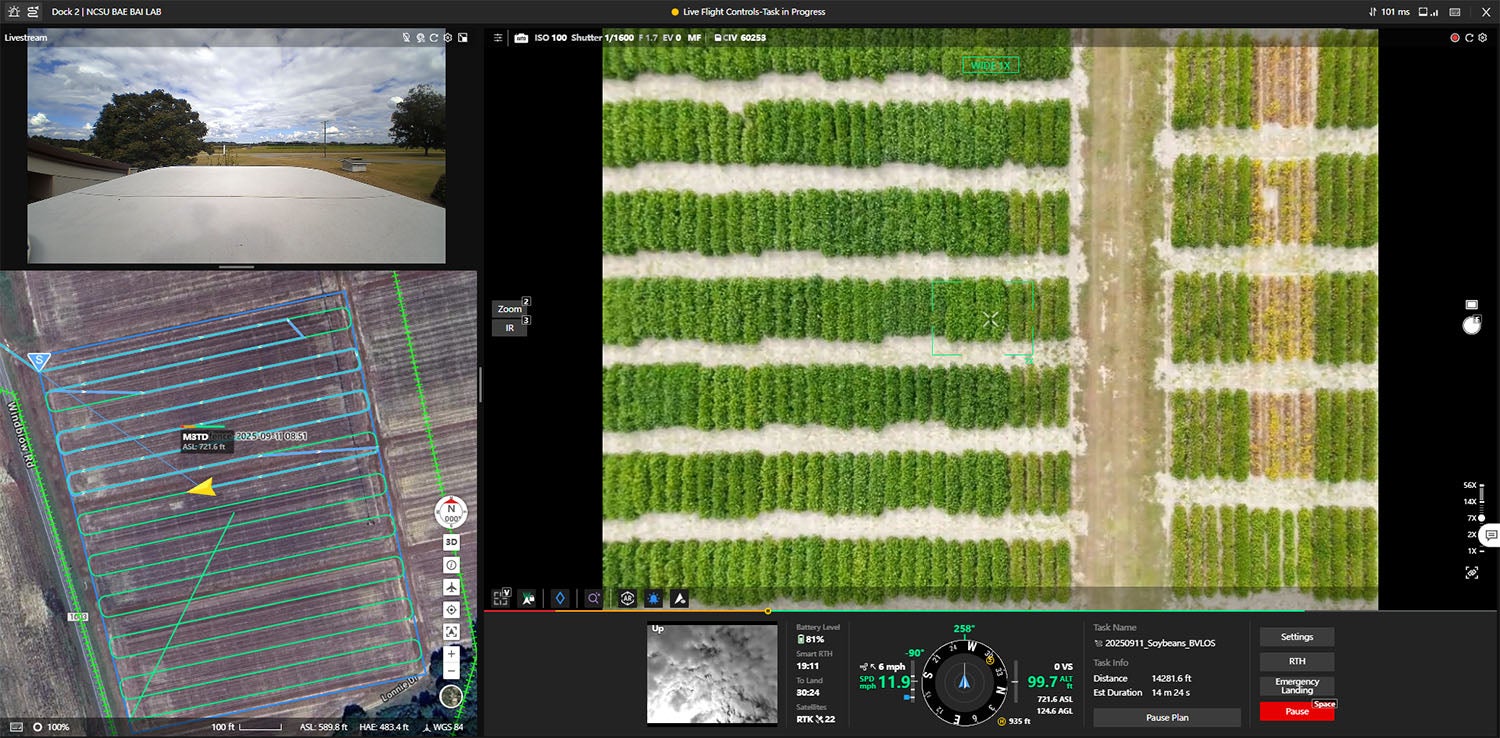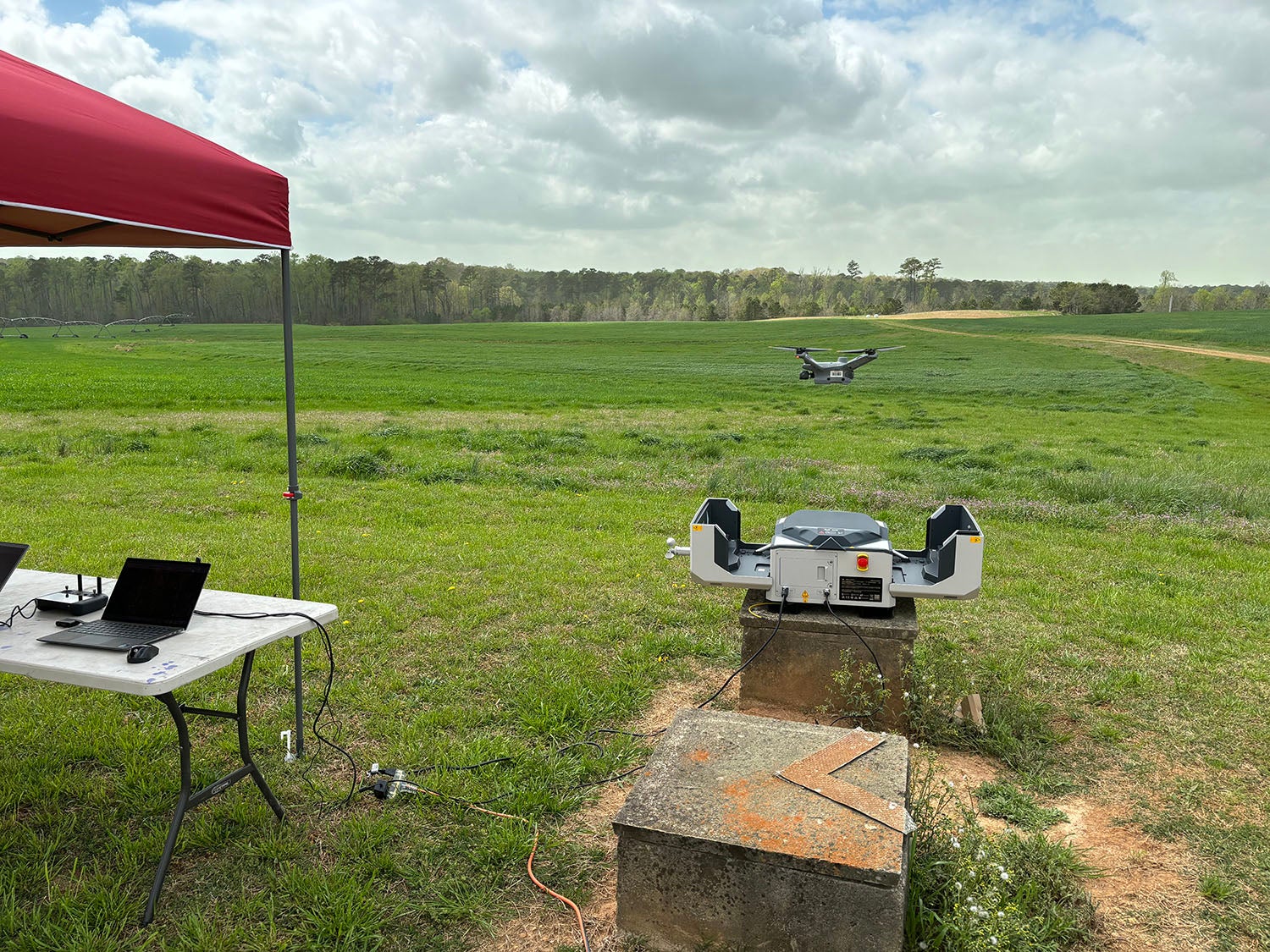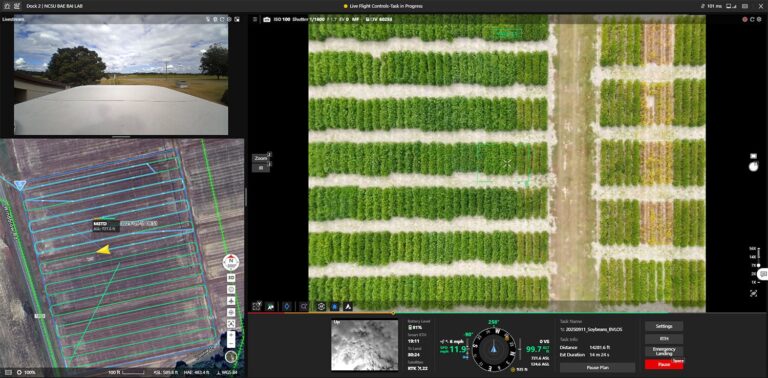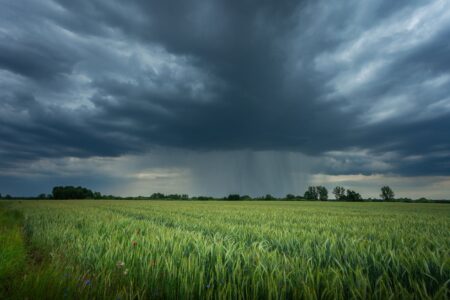For growers and researchers, keeping pace with crop maintenance during the growing and harvest seasons is a massive, time-consuming effort. But the future of crop production could require less hands-on operation with new agricultural technology.
Frank Bai, an assistant professor in the Department of Biological and Agricultural Engineering (BAE) at NC State University, is testing a drone docking solution that he hopes will help growers automatically assess the health of their crops remotely. Bai’s research focuses on developing and applying advanced and reliable technologies in precision and digital agriculture to address gaps in sensing, data processing and application to enhance system efficiency.
Bai has been working on this specific drone project with Justin Macialek, BAE’s research project coordinator, and Trevor Quick, IT systems administrator for BAE. Operating out of NC State’s Sandhills Research Station in Jackson Springs, North Carolina, the team collaborated with the station’s superintendent, Jeremy Martin, to install and configure an autonomous drone system.
The project relies on a shielded BVLOS (Beyond Visual Line of Sight) waiver from the Federal Aviation Administration (FAA) to realize the remote operation. The drone self-launches, flies out to perform its tasks and returns to its docking station to save and send the data it collected.

“Research teams often need to travel a few hours to research stations to collect the data. I believe we are among the first research groups to leverage BVLOS operations within the College of Agriculture and Life Sciences, which can help potentially save significant travel time and the overall operation cost for research projects,” Bai says. “I used to have to stay overnight to collect data in the late afternoon and early morning.”
This technology could help reduce costs related to traveling to and from research sites. Instead of spending a minimum of three hours on the road between Raleigh and the research station to manually fly the drone, Bai can use this drone system remotely to fly on a pre-defined route through fields.
The drone system could also save growers time by doing frequent sweeps of a crop, detecting plant stress early and reporting that to the farmer. Bai’s team hopes to develop this system into an automatic scouting agent that sends field reports to the grower’s phone.
Bai recently test-launched the drone from NC State’s campus. The drone docking system allows the remote pilot to monitor and control the drone through a cloud-based platform.


While the team was observing on a screen in Weaver Laboratories, the drone took flight at the Sandhills Research Station, followed a pre-programmed flight path and gathered data on a soybean field.
Bai has partnered with Ben Fallen, an assistant professor in the Department of Crop and Soil Sciences and research agronomist with the U.S. Department of Agriculture’s Agricultural Research Service. Fallen’s research focuses on altering the genetic lines of soybeans to be more drought-tolerant. The autonomous drone system provides high-frequency data — scheduling hourly flights on selected days — which is crucial for studying plant health and life cycles. The team collects phenotypic data through high-resolution images to precisely measure soybean water efficiency at the field plot level.
“We want to integrate this autonomous drone system, soil and weather data, and models to build a digital tool that simulates crop transpiration at high resolution,” Bai says.
The tool will also allow soybean researchers to perform a genetic analysis of the crop and select the ideal genetics for more resilient plants.
Additionally, Bai plans to incorporate these technologies into his courses, so students can develop an understanding of how precision agriculture and modern technology can be applied together.
“We are proving that this technology can be affordable, reliable and intelligent for not only researchers, but also growers in digital agriculture,” Bai says. “This means future field crop production will be more efficient and potentially autonomous.”
The article was originally published on NC State’s College of Agriculture and Life Science website. It is republished here with permission.


:max_bytes(150000):strip_icc()/WheatField-CloseUp-2000-bc79406da4004a2d94bcb2c32153cc3a.jpg)

:max_bytes(150000):strip_icc()/27451A_SorghumHorizontal_alternative_seed_crops-35e26347f2e4463ab6a7bedce21284f4.jpg)




:max_bytes(150000):strip_icc()/Lauritzen-3genweb-46e9c28830ca495995884be82d9c75b6.jpg)
:max_bytes(150000):strip_icc()/2208-05-044_corn-8740989afb284134bb9074978ef9a094.jpg)
